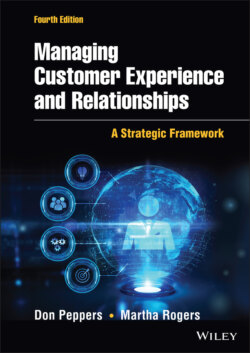Читать книгу Managing Customer Experience and Relationships - Don Peppers - Страница 18
INITIAL ASSESSMENT: WHERE IS A FIRM ON THE CUSTOMER STRATEGY MAP?
ОглавлениеRecognizing that two families of technology have mandated the competitive approach of building customer value by building customer relationships, we can map any organization—large or small, public or private, for-profit or nonprofit—by the level of its capabilities in the arenas of interacting with customers and tailoring for them. A company would be rated high on the interactivity dimension if it knows the names of its individual customers and if it can send different messages to different customers and can remember the feedback from each one. A low rating would go to a company that doesn't know its customers' identities, or does but continues to send the same message the same way to everybody. On the tailoring dimension, a firm would rate highly if it mass-customizes in lot sizes of one; it would rate low if it sells the same thing pretty much the same way to everybody. Based on its rating in these two dimensions, a company can be pinpointed on the Enterprise Strategy Map (see Exhibit 1.2), which includes four quadrants:
Quadrant I: Traditional Mass Marketing. Companies that compete primarily on cost efficiencies based on economies of scale and low price. Companies in this quadrant are doomed to commoditization and price competition.EXHIBIT 1.2 Enterprise Strategy MapSource: Don Peppers and Martha Rogers, Ph.D., Enterprise One to One (New York: Doubleday/Currency, 1997).
Quadrant II: Niche Marketing. Companies that focus on target markets, or niches, and produce goods and services designed for those defined customer groups. This more strategic and targeted method of mass marketing still offers the same thing the same way to everyone, but for a small, relatively homogeneous group.
Quadrant III: Database Marketing. Companies utilize database management to get better, more efficient use of their mailing lists and other customer information. Generally focused primarily on continuation of traditional strategies but at lower costs to serve.
Quadrant IV: Learning Relationships. These are based on individual analytics. Companies use data about customers to predict what each one needs next and then are able to treat different customers differently and increase mutual value with customers.
In Quadrants I through III, the focus is still primarily on the product to be sold, with an eye to finding customers for that product. In Quadrant IV, the direction of the strategy changes; the Quadrant IV company focuses on a customer and finds products for that customer.
To realize the highest possible return on the customer base, the goal of an enterprise will be to move up and to the right on the Enterprise Strategy Map.
To move up on the Enterprise Strategy Map, an enterprise has to be able to recognize individual customers' names and addresses, or at least coded identities, to send different messages to different customers, and to remember the responses of each.
To move to the right on the Enterprise Strategy Map, an enterprise has to be able to increase its production and logistics flexibility. The most flexible production would entail customizing and delivering individual products for individual customers. The least flexible would be mass-producing a standardized product or service for a large market. (We talk more about customization in Chapter 10.)
